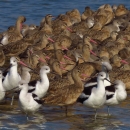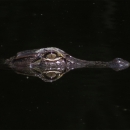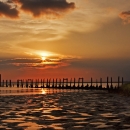Visit Us
No Visitor Center.
The St. Vincent NWR administrative office is located in the historic Fry-Conter house in Apalachicola Florida.
Points of Interest
St. Vincent Island, a 12,300 acre undeveloped Gulf of America barrier island accessible only by boat, is the most visited Refuge unit. Paved boat ramps with no cost parking are available at the end of Gulf County Road 30-B (Indian Pass Peninsula Road) and at Ten Foot Hole under the John Gorrie Bridge in Apalachicola. St. Vincent Island offers miles of undeveloped beaches and unimproved trails for hiking, bicycling, wildlife viewing, nature study, and photography. Bank fishing is allowed year round. Three public hunts are offered each year from November – January.
Pig Island, a 46 acre undeveloped island located in southwestern St. Joseph Bay, is also accessible only by vessel. Care must be taken not to damage sea grass beds in the shallow waters surrounding this small Refuge island.
The 86 acre 14 Mile mainland site is located along Franklin County Road 30-A midway between the towns of Port St. Joe and Apalachicola, Florida.
All Refuge units, except the 11 Mile mainland site, are open to the public at no cost during daylight hours. No vessels are allowed overnight.
Know Before You Go
The Refuge is open at no cost each day during daylight hours. The Refuge is closed to the general public during public hunts, and may be closed during fires or tropical storms. Visitors are responsible for their own transportation to and from the Refuge. The Apalachicola Chamber of Commerce maintains a list of private for-profit vendors who provide the service of boating people to and from the Refuge for a fee.
There are no facilities or potable drinking water available on any of these National Wildlife Refuge units. Visitors are welcome at no cost but should bring their own drinking water, insect repellant, and sunscreen.
Boaters should make themselves aware of local marine conditions including tidal fluctuations and currents.
Overnight camping and fires are only allowed during Refuge public hunts.
On St. Vincent Island, there are a number of sand roads that are open to foot and bicycle traffic; however, there are few trail signs, road signs or directional signs, so visitors are on their own exploring the island. Access to the primitive beaches, dense stands of cabbage palms, wild vistas over marshes, and Bay waters provide excellent wildlife viewing and photography for visitors.
Other Facilities in the Complex
St.Vincent NWR is managed as part of the North Florida Refuges Complex.
The North Florida National Wildlife Refuge Complex encompasses the St. Marks National Wildlife Refuge and the St. Vincent National Wildlife Refuge and associated conservation easements across 13 counties in southwestern Georgia and the Florida panhandle protecting close to 95,000 acres for wildlife. The addition of Lower Suwannee National Wildlife Refuge and Cedar Keys National Wildlife refuges unifies our national wildlife refuges along Florida’s “Big Bend” or “Nature Coast,” which is one of the largest, undeveloped, mostly privately-held coastal areas in the nation.
The Refuge Complex headquarters is located at 1255 Lighthouse Road, St. Marks, FL 32355.
Locations























